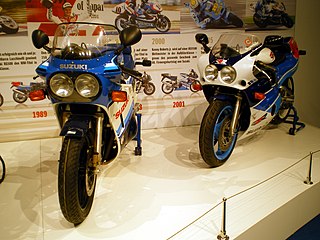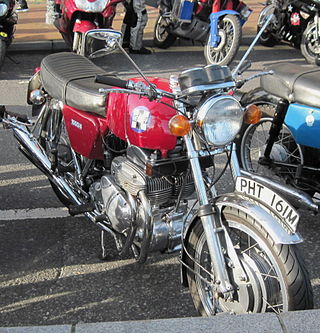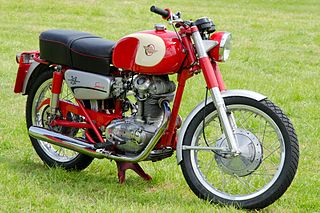
Fritz W. Egli, (born June 30, 1937, in Zurich) is a Swiss former motorcycle racer. He is known as a motorcycle frame specialist, and engine tuner.

Fritz W. Egli, (born June 30, 1937, in Zurich) is a Swiss former motorcycle racer. He is known as a motorcycle frame specialist, and engine tuner.

Egli founded his motorcycle speed shop in 1965. One of his first vehicles included a Vincent Black Shadow, [1] with what was to become his signature large diameter central tube which won a 1968 motorcycle hill climb championship. He went on to become famous for his frame designs for the large Japanese motorcycle engines of the 1970s, especially the Honda CB750 Four and the first big four-stroke motorcycles of Kawasaki. His large diameter tube frame design later incorporated a honeycomb internal section which was suggested by a visiting Australian in 1979. This suggestion greatly increased the rigidity of the frame. Today, he builds frames for the Yamaha V-Max and others. [2]
Egli took the Japanese engines, enhanced them for increased power, then placed them into his own frame designs. [3] The main backbone pipe of his designs are about 12 cm in diameter and they use straight pipes exclusively, avoiding the "bends and curlicues" [4] of frames such as the Norton Featherbed. Egli-framed motorcycles have an enthusiastic following which meets annually.[ where? ]
Egli influenced other frame builders who went on to build their own 'straight-tube' frames, including the Healey brothers whose Healey 1000/4 motorcycle comprised an uprated Ariel Square Four engine within an Egli-type frame.

A chopper is a type of custom motorcycle which emerged in the US state of California in the late 1950s. A chopper employs modified steering angles and lengthened forks for a stretched-out appearance. They can be built from an original motorcycle which is modified ("chopped") or built from scratch. Some of the characteristic features of choppers are long front ends with extended forks often coupled with an increased rake angle, hardtail frames, very tall "ape hanger" or very short "drag" handlebars, lengthened or stretched frames, and larger than stock front wheel. To be considered a chopper a motorcycle frame must be cut and welded at some point. I.e. the name chopper. The "sissy bar", a set of tubes that connect the rear fender with the frame, and which are often extended several feet high, is a signature feature on many choppers.

A U engine is a piston engine made up of two separate straight engines placed side-by-side and coupled to a shared output shaft. When viewed from the front, the engine block resembles the letter "U".

Suzuki GSX-R is a series of sports motorcycles made by Japanese automotive manufacturer Suzuki since 1984.

The term "Universal Japanese Motorcycle", or UJM, was coined in the mid-1970s by Cycle Magazine to describe a proliferation of similar Japanese standard motorcycles that became commonplace following Honda's 1969 introduction of its successful CB750. The CB750 became a rough template for subsequent designs from all three of the other major Japanese motorcycle manufacturers. In 2011, the New York Times said lightning struck for Honda "with the 1969 CB 750, whose use of an inline 4-cylinder engine came to define the Universal Japanese Motorcycle."

A café racer is a genre of sport motorcycles that originated among British motorcycle enthusiasts of the early 1960s in London. Café racers were standard production bikes that were modified by their owners and optimized for speed and handling for quick rides over short distances. Café racers have since become popular around the world, and some manufacturers produce factory-made models that are available in the showrooms.

Vincent Motorcycles was a British manufacturer of motorcycles from 1928 to 1955. The business was established by Philip Vincent who bought an existing manufacturing name HRD, initially renaming it as Vincent HRD, producing his own motorcycles as HRD did previously with engines purchased as complete assemblies from other companies. From 1934, two new engines were developed as single cylinder in 500 cc and v-twin 1,000 cc capacities. Production grew from 1936, with the most-famous models being developed from the original designs after the War period in the late 1940s.

The Vincent Black Shadow is a British motorcycle designed and built at the Vincent works in Great North Road, Stevenage, Hertfordshire UK. Motorcycles produced by Vincent H·R·D at their factory in Stevenage, Hertfordshire, England were renowned for their design innovation, engineering excellence and high performance. Already advertising their existing 110 mph Rapide machine as "The world's fastest production motorcycle", in February 1948 the distinctive Vincent Black Shadow was announced with a top speed of 125 mph. Built in three different Series over the course of its life, the line continued until 1955, after which the company stopped all motorcycle production.

A motorcycle engine is an engine that powers a motorcycle. Motorcycle engines are typically two-stroke or four-stroke internal combustion engines, but other engine types, such as Wankels and electric motors, have been used.

The Cotton Motor Company, was a British motorcycle manufacturer of 11a Bristol Road, Gloucester, and was founded by Frank Willoughby Cotton in 1918. F.W. presided over the company until his retirement in 1953. The company was reconstituted as E. Cotton (Motorcycles) Ltd, and traded until 1980. The marque was later resurrected in the late 1990s by a business which manufactured replicas of earlier machines.

Miyata is a Japanese manufacturer of bicycles, unicycles and fire extinguishers. The company has been in operation since 1890. Miyata was also one of the first producers of motorcycles in Japan under the name Asahi. The Asahi AA was the first mass-produced motorcycle in Japan.

The Ducati singles were single cylinder motorcycles, made by Ducati from 1950 to 1974. Chief Engineer Fabio Taglioni developed a desmodromic valve system in these years, a system that opens and closes the valves using the camshaft, without the need for valve springs. This valve system has become a trademark feature of Ducati motorcycles.

The BSA Gold Star is a motorcycle made by BSA from 1938 to 1963. They were 350 cc and 500 cc single-cylinder four-stroke production motorcycles known for being among the fastest bikes of the 1950s. Being hand-built and with many optional performance modifications available, each motorcycle came from the factory with documented dynamometer test results, allowing the new owner to see the horsepower (bhp) produced.

A motorcycle frame is a motorcycle's core structure. It supports the engine, provides a location for the steering and rear suspension, and supports the rider and any passenger or luggage. Also attached to the frame are the fuel tank and battery. At the front of the frame is found the steering head tube that holds the pivoting front fork, while at the rear there is a pivot point for the swingarm suspension motion. Some motorcycles include the engine as a load-bearing stressed member; while some other bikes do not use a single frame, but instead have a front and a rear subframe attached to the engine.

The featherbed frame was a motorcycle frame invented by the McCandless brothers and offered to the British Norton motorcycle company to improve the performance of their racing motorcycles in 1950. It was considered revolutionary at the time, and the best handling frame that a racer could have. Later adopted for Norton production motorcycles, it was also widely used by builders of custom hybrids such as the Triton, becoming legendary and remaining influential to this day.

The Healey 1000/4 is a British motorcycle made by the Healey brothers between 1971 and 1977. Fitted with an improved Ariel Square Four 1000 cc engine, the Healey was cheaper than a Honda Gold Wing, but only 28 Healey motorcycles were ever built.

The Suzuki GSX-R1100 is a sport bike from Suzuki's GSX-R series of motorcycles produced from 1986 until 1998.

Colin Jordan Seeley was a British motorcycle retailer who later became a motorcycle sidecar racer, motorcycle designer, constructor and retailer of accessories. In 1992 he was involved in running the Norton Rotary race team.

The Norton Model 88 Dominator, also originally known as the Dominator De Luxe was a 500 cc vertical twin motorcycle manufactured by the British Norton Motorcycle Company from 1952 to 1966. It was the first of Norton's motorcycles to use the featherbed frame, which established Norton's reputation of producing fine handling machines. The 88 used the Bert Hopwood designed engine that was first fitted to the Model 7 and was initially for export only. It became available on the home market in 1953. Norton were a small manufacturer at the time and without the economies of scale the model was expensive compared to other manufacturer's equivalent machines. The 88 retailed for 20% more than the contemporary Triumph Speed Twin and was dearer than the 650 cc Triumph Thunderbird.

The Ducati Sebring is a 340 cc (21 cu in) single cylinder bevel drive SOHC motorcycle produced by the Italian manufacturer Ducati from 1965 to 1968. At the time of its introduction it was the largest capacity Ducati machine. Production of the original model ended in 1967 when the 'wide case' Mark 3 was introduced, although just over 200 Sebrings were made in 1968 with the 'wide case' engine. Total production was around 3,500 machines.
Slater Brothers was a British, and later American, motorcycle dealer and importer. They are best known as the UK importers of Laverda motorcycles, and for developing high-performance versions of Laverda models, especially the Jota.